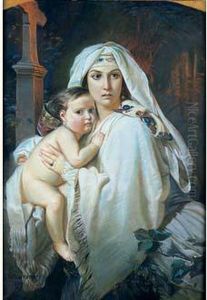Eugene Lemonnier Paintings
Eugène Lemonnier was a French painter born in 1845 in the city of Caen, in Normandy. He is often categorized as part of the Naturalist movement, which was an offshoot of the Realist movement, focusing on the more scientific and empirical aspects of representation. Lemonnier's works often depicted scenes from everyday life, imbued with a sense of authenticity and a focus on the human experience.
Lemonnier showed artistic promise from an early age and was encouraged to pursue his talents. He studied at the École des Beaux-Arts in Paris, which was the foremost art school in France at the time. Under the tutelage of established painters, he honed his skills in drawing and painting. He was particularly influenced by the works of Gustave Courbet and Jean-François Millet, who were leading figures in the Realist movement. Lemonnier's paintings often reflected the ordinary lives of rural and working-class individuals, similar to the subjects favored by his Realist predecessors.
In the 1870s, Lemonnier's work began to gain recognition. He exhibited at the Paris Salon, which was the official art exhibition of the Académie des Beaux-Arts in Paris. His paintings received positive reviews for their attention to detail and the emotional depth of their subjects. Lemonnier was also known for his landscapes, which he painted en plein air, a technique that became increasingly popular among artists of his time. These landscapes often featured the countryside of Normandy, capturing the unique light and atmosphere of the region.
As his career progressed, Lemonnier continued to exhibit his work and received various accolades. He remained dedicated to his Naturalist roots, portraying the world around him with a sense of fidelity and a compassionate eye. Despite the rise of new art movements such as Impressionism and Post-Impressionism, Lemonnier stayed true to his stylistic convictions, which earned him a loyal following among art collectors and enthusiasts.
Eugène Lemonnier's contributions to the art world were significant, particularly in the context of French Naturalism. His paintings captured the spirit of the times and provided a window into the lives of ordinary people at the turn of the 20th century. Lemonnier died in 1935, leaving behind a body of work that continues to be appreciated for its honesty and craftsmanship.
